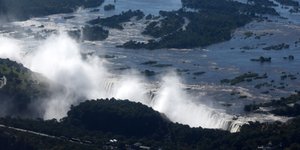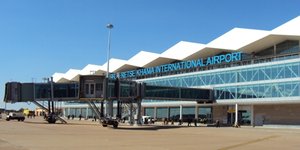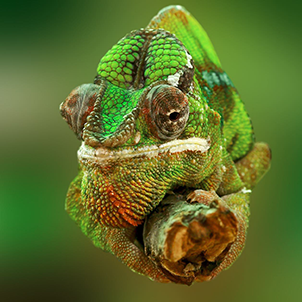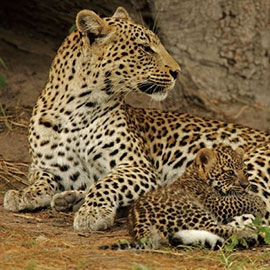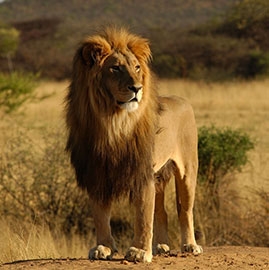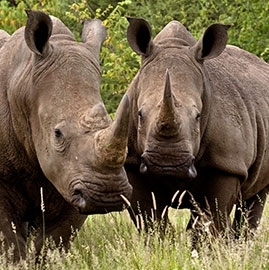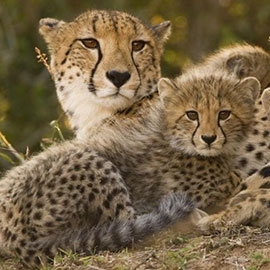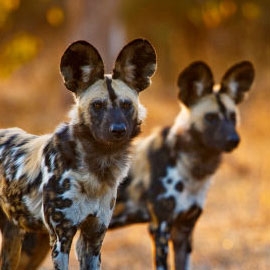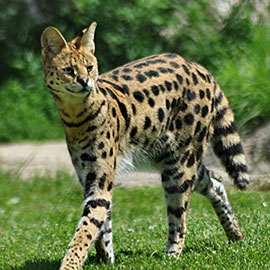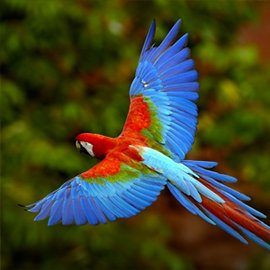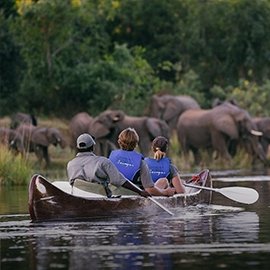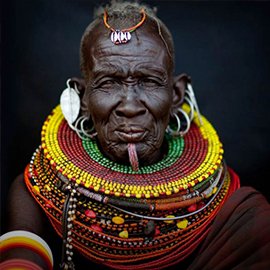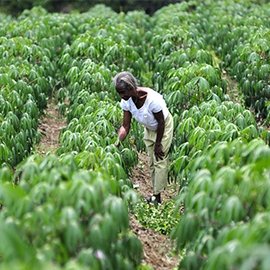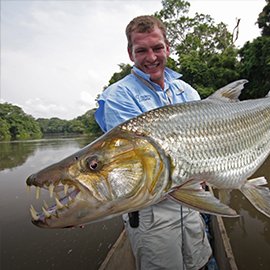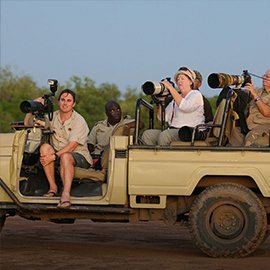Chobe National Park
Safari suitability: 9/10
Find your tourFour of the big five and ample variety and quantity of wildlife make this a great choice.
What YAS members think
Highlights
- Chobe gates are open 6am to 18h30 from 1 April to 30 September
- Chobe gates are open 5:30am to 19h00 from 1 October to 31 March
- Close proximity to Victoria Falls National Park
- One of the greatest concentrations of elephants in all of Africa
- Best time to visit runs between November and March
- Savuti Canal offers great wildlife viewing.
About Chobe National Park
Located in northern Botswana and established in 1967, Chobe National Park offers a stunning array of wildlife. At 10,566 km² (4080 mi²), Chobe is Africa’s 13th largest national park and the third largest in Botswana after Central Kalahari and Gemsbok. The park is named after the Chobe River, which runs through the park and is a lure for the large concentrations of herbivores that come to drink, especially elephants.
Chobe wildlife
Chobe is home to several large animals and one can find four of the five big five here, with the rhino being the only one that has rarely been seen in this area. One of the greatest concentrations of elephants in all of Africa can be found in Chobe, and a safari here is guaranteed to have several elephant viewing opportunities. It is also possible to see lions, leopards and cheetahs in Chobe along with countless species of birds.
Botswana has a very well-developed safari infrastructure and offers a high-standard of safari accommodation. Because it is a national park, its gates are closed before sunrise and after sunset. This means game drives before dawn or after sunset are not allowed, which has resulted in most lodges being located outside the park. It is highly recommended for beginner and expert safari goers alike. Its proximity to other major tourist destinations, including: Okavango Delta, Central Kalahari and/or Victoria Falls, make it a highly desirable travel destination.
Of notable mention is the Linyanti Game Reserve or Concession. This small area of land is in the north western corner of the Chobe National Park, northeast of the Okavango Delta in Botswana. Eponymously named by the river that runs through it, Linyanti is best known for the large numbers of elephant that roam the reserve. It has recently become one of the best places to see theAfrican wild dog, driven virtually to the edge of extinction—roughly 6600 exist in the wild today. Safaris here promise the true Botswana experience.
Savute Channel | Savuti Canal
The Savuti Marsh is located in the western portion of Chobe and is fed by the Savuti Canal, also referred to as the Savute Channel. The flow of water in this canal feeds the marsh. The flow is erratic and the channel can remain dry for years. Savute is known for its spotted hyenas and lions. It also has excellent birdlife and a wide variety of herbivores. To the west of Savuti is the private Kwando Concession, which is listed under Okavango Delta on YAS.
When to visit Chobe National Park
Chobe National Park has two distinct seasons: a wet season and a dry season. The wet season starts around mid-October and runs through mid-March. As many of the safaris in Chobe are in a boat along the Chobe River, the increased precipitation often has no impact on ease of accessibility. The wet season does mean the concentration of animals is lower as water supplies become more abundant. The dry season, which runs from November through March means lower water levels and higher concentrations of wildlife.
 United States
United States
No matter what language you speak, you're most liking going to be saying something similar to the person next to you--elephants! Chobe is riddled with these pachyderms, and it is truly a sight to behold. Chobe's proximity to Victoria Falls means it has more tourists than I tend to like on safari, but it is possible to have a somewhat remote experience by paying extra for your own vehicle, which we did. I highly recommend it. I would see vehicles laden with tourists, their heads all bobbing around inside the vehicle, vying for a good vantage point, and thought how miserable I would have been in this situation. Chobe also allows for self-drive safaris, and I recommend trying to get off the main drag to help eschew the hordes.
Sort by:

Chobe National Park truly lives up to its reputation as a must-visit destination for wildlife enthusiasts. Boasting the largest elephant herd in the world and a vast array of other incredible wildlife, it's a spectacle that should not be missed. A Wildlife Lover's Dream: Chobe's sheer abundance of wildlife is breathtaking. The massive elephant herds are a highlight, but the park is also home to lions, leopards, buffalo, giraffes, zebras, and many birdlife. The diverse ecosystem, coupled with the park's vastness, ensures a truly immersive wildlife experience. Beyond the Wildlife: Chobe offers a wide range of activities to cater to different interests. Whether you're keen on game drives, boat safaris, or exploring the surrounding landscapes, there's something for everyone. This variety adds to the overall appeal and ensures a dynamic and engaging experience. Luxury & Comfort: The presence of luxurious camps enhances the overall experience, providing a comfortable and opulent base from which to explore the park. These camps offer a blend of comfort and wilderness, allowing visitors to truly relax and enjoy their vacation without compromising on luxury. Verdict: Chobe National Park is undoubtedly a top-tier destination for anyone seeking a wildlife adventure. The sheer abundance of wildlife, the variety of activities, and the luxurious accommodation options make it a truly exceptional experience. If you're planning a safari in Botswana, Chobe should be at the top of your list. It's a destination that delivers on every promise and leaves you with unforgettable memories.

Chobe National Park is the best way for one to get to see wildlife, the greatest surprise is the seeing lions in the park, and if you are lucky you will get to see a leopard walking down to the Chobe River. The game drive will give you an authentic experience with wildlife being so close and in their natural habitat. The river safari is calm and seeing waterbucks grazing on the islands is thrilling as you get to watch them swimming back to the banks of the Chobe River.

Chobe National park is a magnificent gesture for tourists with its flora and fauna. It is popular with many herds of elephants and buffalo. Its popularity has attracted the whole world.

I went with my family in this park which is bordering three countries it was not what I expected but more than our expectation ,This was great seeing the big herd of elephants and hippopotamus. We will definitely tell our friends.

I was lucky enough to go on a boat cruise on the Chobe River. You depart from near Kasane town and go on a 2 to 3 hour boat cruise maximum 20 to 25 persons. I do suggest going on a smaller boat than a large boat, more personal. I thought I was on a wildlife TV programme as we got to see so many elephants along the river banks and hippos in the water. This area has the largest concentration of elephants in the world and I can easily see how that is possible. Morning or sunset boat cruise is recommended.
In 2018 my husband and I had to opportunity to go to Chobe National Park. We headed out on a boat ride first in the afternoon to see the animals come down to drink. To our left along the riverbank we watched as a herd of elephants made their way down to the water for a drink. This group was so close and we were able see young elephants in between all the adults. Botswana is an amazing place to see elephants. With the worlds largest population, there is no chance of not seeing them in nature reserves. As the boat took us further down the river, we saw a bachelor herd of four large bulls who were knee deep in the long grass/water. We stayed awhile watching them eat and wade through the water only 5 metres away from the boat. We were also surrounded by waterbuck, buffalo and crocodiles basking on the riverbank. The next day we headed back into the park by car. It was very early when we headed out, still dark. Morning in Africa is a fantastic time to start a safari, the wilderness just comes alive. We saw hippos grazing and then heading back to the water for the day, as well as lots of antelope grazing near the water. The amazing experience we had at Chobe was the moment we spotted two adult female lionesses with six cubs. We managed to follow them for a little bit at a distance as not to disturb them. We turned our car off and they eventually made their way past our car. It is a large park however we did find that especially when there was an apex predator (the lions) that a lot of cars turned up. A few self-touring cars were very pushy, driving through certain areas to get close to the lions and two cars even separating three of the cubs from the rest. Other than that, the rest of our drive throughout the day was almost like we were completely alone just wilderness surrounded us. I recommend this park greatly and, although we did not see all of the big five, there is still an abundance of wildlife in an untouched area. If you are an elephant lover then Chobe and Botswana is definitely the place to visit.
We spent one night in Kasane by the Chobe river. On our arrival we went on a sunset cruise and the following morning on a game drive by the river. We saw a few elephants having a drink, giraffes, an iguana lying in the late sun, another elephant bathing in the marsh, several different species of birds and hippos, of course; but what we enjoyed the most was the beautiful sunset. To our minds, if you want to see wildlife, you go to the bush or savanna is there a difference? The highlight of the game drive was a herd of buffaloes munching the grasses while three hungry female lions delicately approached. It was apparent that a group of nearby impalas were on the alert. Wildlife can be cruel but its about survival. What as "civilized" human beings do we do? We recommend the short flight to Savute. One feels small but privileged to see the immensity of the bush. Unfortunately the Savute channel has dried but the grasses are luxuriant and fragrant and although high at the close of the rainy season towards the end of April, you can still spot lions with their cubs taking a nap with their four legs in the air. Elephants were not so prolific as we'd expected - had they migrated ? - but giraffes welcomed us on the airstrip and zebras stood still as we took photos. But perhaps what has left a print are the wide plains of high grass, the baobas trees - one a thousand years old - a cub turning around to face us, the splendour of a majestic male lion at sunset, the fragile elegance of the giraffes, ... . We stayed at the intimate and well integrated into the environment Savuti Camp composed of five tents with all you need - a comfortable bed, hot running water, good food and the extraordinary possibility to doze off and wake up to the sound of a hyena, a lion or perhaps an elephant.
Savuti is a great place to experience the African savannah. It has a variety of landscapes from open plains, river beds and rivers, to more bushy areas.In this review, I'm writing about my experiences around the Savuti Campsite and general wildlife spottings in Chobe. Savuti, Chobes plains, are full of wildlife Overall, Savuti in Chobe National Park is what I expected from a safari park in Africa: some sandy roads, tones of wildlife, great sceneries, and much more. There are also ancient rock paintings here--for those who are willing to look. Obviously, I had to go and check it out, but it was very small. We also mat a couple of people who went searching for it but didnt find it. Its also not really crowded and it has a decent road system (sandy roads), which allow you to find areas which are quite remote. They also have impressive baobab trees (although I cant compare to other areas), but they are just a great addition to the semi-open landscape. The Savuti campsite is a very nice place with the ability to drive in a lot of different directions. As the camp is not fenced, you have the ability to already see wildlife in the camp. Near the restrooms, Ive spotted a mongoose. On one of the days, we had elephants in the camp. At first, it was a pleasant sighting, but some of the tourists left some food hanging around, and the elephants were exploring their camping area. Just take it in mind when you go out camping. You are in the living space of the wild animals, do your best not to interact with them. Close to the Savuti campsite, there is a bridge over the Savuti canal, around there we were lucky to see some wild dogs. We were just too late to see the kill, but we could observe them nicely. Although the park rangers were a bit more sceptical, as the kill was very close to their office. They decided it was better to scare them away. Not too pleasant for the tourists, although we all could have a very good sight of them. But in the end the park rangers did a good job, they should try and keep the distance between the animals and the people. Overall, the Rangers are very friendly. South of the Savuti Campsite, you have amazing possibilities to spot wildlife. You can follow a trail along the Savuti Canal and hope to see some animals near the water. This area is a bit bushier but was very good for herbivores. Going South on the Sandridge Road will bring you to a more open area. These areas are amazing for spotting impala, greater kudu, elephants, giraffes, and much more. We even spotted lions and a civet on the road. Maribou Pan is another great place to spot some wildlife. Chobe is known for its large density of elephants, and it will not let you down. We've seen plenty of elephants, sometimes large groups. We had an amazing time here, enjoying the wildlife to its fullest. Our next stop was Chobe Riverfront.
The road from Savuti towards Chobe Riverfront is long and sandy, but very nice though. You are going from the very remoteness of Savuti (Chobe) towards Kasane, which is the biggest town around Chobe Riverfront. You slowly make your way back to civilisation. Kasane is a very nice town with a lot of options (food, accommodation, activities) and is the place to be to book some activities. That's where we booked our boat safari. Personally, I think boat safaris are the best way to explore the Chobe Riverfront, or at least to get a notion where it's all about. There are a lot of different options, from taking a small boat specialised in photography to a large boat with deck. I went for a small boat for about 12 people or so. You get nice and close to some of the animals and it's a great opportunity to take some pictures. Although it's a tough job to keep your camera steady with waves from different boats. On the boat safari, I did not get the feeling of being very remote. There were a lot of different boats around and often they were queuing. This being said, I also heard about safaris going deeper into the Riverfront (which might be less crowded). Anyway, this safari was a great experience. Exploring the Chobe Riverfront on land was also very nice. It has a combination of more forested areas and plains. It's definitely worth checking out the roads near the river around sunrise and definitely sunset (even if it's just for the nice sunset above the river. They have a couple of nice campgrounds and picnic places. Again, beware of the animals, I've seen monkeys stealing food and lions wondering along the picnic sites. So just remember you are still in the wilderness.
Just returned from my second trip in 1 year to Savute in Chobe. Once again it never fails to impress. Top-class predator encounters, large herds of elephant, incredible landscapes, endless game drives without a fence or human habitation, aside from a handful of lodges. Stayed at the Belmond Savute Elephant Lodge this year, and at Savute Desert and Delta last year. Both are excellent properties with great swimming pools looking directly onto the waterholes below. Very experienced rangers who really make the whole experience that much more interesting. These two lodges also now have Kosher separated kitchens, and are ready to host Jewish clientele.
Chobe is accessible via 4x4 vehicle and by airplane. It is roughly 70km / 44 miles from Victoria Falls, Zimbabwe and will take roughly an hour. This makes Chobe a popular safari destination for those visiting Victoria Falls. Air Botswana flies to Kasane, the local airstrip for Chobe.
Entrance gates for Chobe
There are a number of different gates where you can pay your park fees and enter the park. The main entrance is at Sedudu Gate in the north-east of the park near the town of Kasane. Then there is Ngoma gate near Namibia, which can be accessed by the public road that runs for 54 kilometres through the park and is used by visitors from Namibia and those stating in the Chobe Enclave. The southern entrance to the park is at Mababe gate along a route that connects with Moremi Game Reserve. This gate is 56km south of Savute.
Many visitors use charter companies based in Maun to fly to the various lodges in Botswana. These include Delta Air, Mack Air, Moremi Air Services, Wilderness Air, Wildlife Helicopters and Kalahari Air Services. It is also possible to drive from Maun to Chobe, and take between 8.5 and 13 hours. You will want to ensure you’ve plenty of fuel, as there are no stations between the two parks.
The following airlines travel to Chobe National Park

Botswana's national carrier. Air Botswana, Botswana's national carrier is the flagship and pride of Botswana. Today, Air Botswana enjoys a wide and acclaimed reputation quite disproportionate to its modest size as a model, quality airline. Currently, Air Botswana operates and maintains a fleet of BAE 146 as well as ATR42-500 and ATR72-500 advanced turbo propeller aircrafts which operate daily domestic and regional scheduled flights. Visit website
Also flies to:




At Air Shakawe we offer a range of flights to suit every travellers need. Based at Maun International Airport, we operate daily flights over the Okavango Delta as well as to lodge transfers between the various lodges in Botswana. With regular flights between Limpopo Valley, Maun and Kasane we make it possible for travellers to connect to their next destination in the quickest possible way. We strive to provide every passenger with the best possible service, to have fun and experience Botswana from the air with breathtaking views of the Okavango Delta. Scenic flights over the Okavango Delta are one of the most popular activities there is to offer while passing through Maun. Whether you are the avid overland traveller with a limited budget or require an exclusive private flight, we can arrange it all. Safety is a top priority, our crew is trained by highly experienced pilots and undergo flight tests every 6 months. Contact Air Shakawe for your next personal or business trip, and be assured of an exclusive, convenient and safe journey. Visit website
Also flies to:


Botswana-based Helicopter Horizons is an experiential helicopter company, specializing in helicopter experiences for every traveler to the Okavango Delta, Makgadikgadi Pans, and the Kalahari Desert. From scenic and photography flights to private transfers, helicopter safaris, and various helicopter experiences such as village & Tsodilo Hills tours. Our team of over 10 pilots from around the world are highly experienced and extremely passionate about sharing their love of the region with each and every guest on board. Experiencing the incredible lagoons, crystal clear channels, and islands of the Okavango Delta is best from above, where you get to see the full expanse of this indescribable region. Explore Your World! Visit website
Also flies to:


Kavango Air was established in 2005 by Mark Smith who has been operating aircraft in northern Botswana since 1990. Kavango Air strives to keep safety its first priority, punctuality its second and also keeping the flight enjoyable at the same time. Based in Maun (Botswana) on the edge of the Okavango Delta, it is ideally positioned for quick scenic flights over the delta, as well as camp transfers to the numerous lodges and camps in the delta and surrounding areas. Kavango Air does air charters to almost anywhere in Southern Africa, and also does medical evacuations. The crew receives extensive training in bush flying techniques, and the pilots have to adhere to the high safety standards instilled by the company. Visit website
Also flies to:






MACK AIR is a fixed-wing charter company operating from Maun International Airport in northern Botswana. Based in Maun, the gateway to the Okavango, our destinations are throughout Botswana and neighbouring countries reaching as far as Johannesburg, Victoria Falls, Vilanculos and Windhoek. Visit website
Also flies to:



Majestic Air provides a highly efficient service to travelers who wish to avoid the tedium of travel on South Africa's congested roads and in railways. Majestic Air is owned by David Maree who, as a businessman and commercial pilot, has used aircraft for business travel within South Africa and neighbouring countries. He has personal experience of the practical and cost-effective benefits of the use of aircraft as an alternative to travel by car and train. Majestic Air is operated by Multimedia Entertainment Group Air (PTY) Ltd) trading as MEGA Air as Air Charter & schedule Company in South Africa. The Company was established in the year 2004. Their aircrafts are capable of operating to smaller or rural airports where scheduled services are not able to. Visit website
Also flies to:




Wilderness Air is proud to be the air partner of Wilderness Safaris, a responsible ecotourism and conservation company with private access to the finest wilderness and wildlife areas of southern Africa. Wilderness Air began operating in 1991, with one aircraft based in Botswana servicing two camps in the Okavango Delta. Today, Wilderness Air is also based in Namibia, Zambia and Zimbabwe, operating over 35 aircraft and employing over 50 pilots. Throughout its time, it has maintained its excellent reputation for safety and guest service. We operate a varied fleet of light aircraft, chosen for their ability to transport visitors comfortably to remote wilderness destinations with dirt airstrips. Each aircraft type has been selected based on its ability to transport different numbers of passengers, over different ranges. Our fleet operates on a daily circuit within the regions. Wilderness Air is privileged to fly into some of the most pristine wilderness areas in the world. We believe that flying is an integral part of each guest's travel experience and that our pilots' passion and professionalism can make a genuine contribution to journeys that change lives. Visit website
Also flies to:




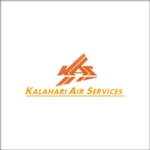
Established in 1968, Kalahari Air Services is Botswanas most experienced commercial maintenance and air charter service provider. With our dedicated fleet and crew, we offer safe, reliable and efficient private charters throughout Southern Africa. A flexible and dynamic company, we offer a wide range of aircraft services to meet your needs. Please see our services page for further details on all our services, such as medical rescue, freight and aircraft acquisition, and sales. Visit website
Also flies to:



Airlink is a privately-owned, BBBEE Level 4 business and regional airline serving a comprehensive network of smaller destinations throughout Southern Africa. We are now operating independently under our own unique 4Z flight code offering more freedom, more choices and more travel opportunities. Visit website
Also flies to:









Chobe map
Nearby parks and game reserves
Related articles
Latest photos
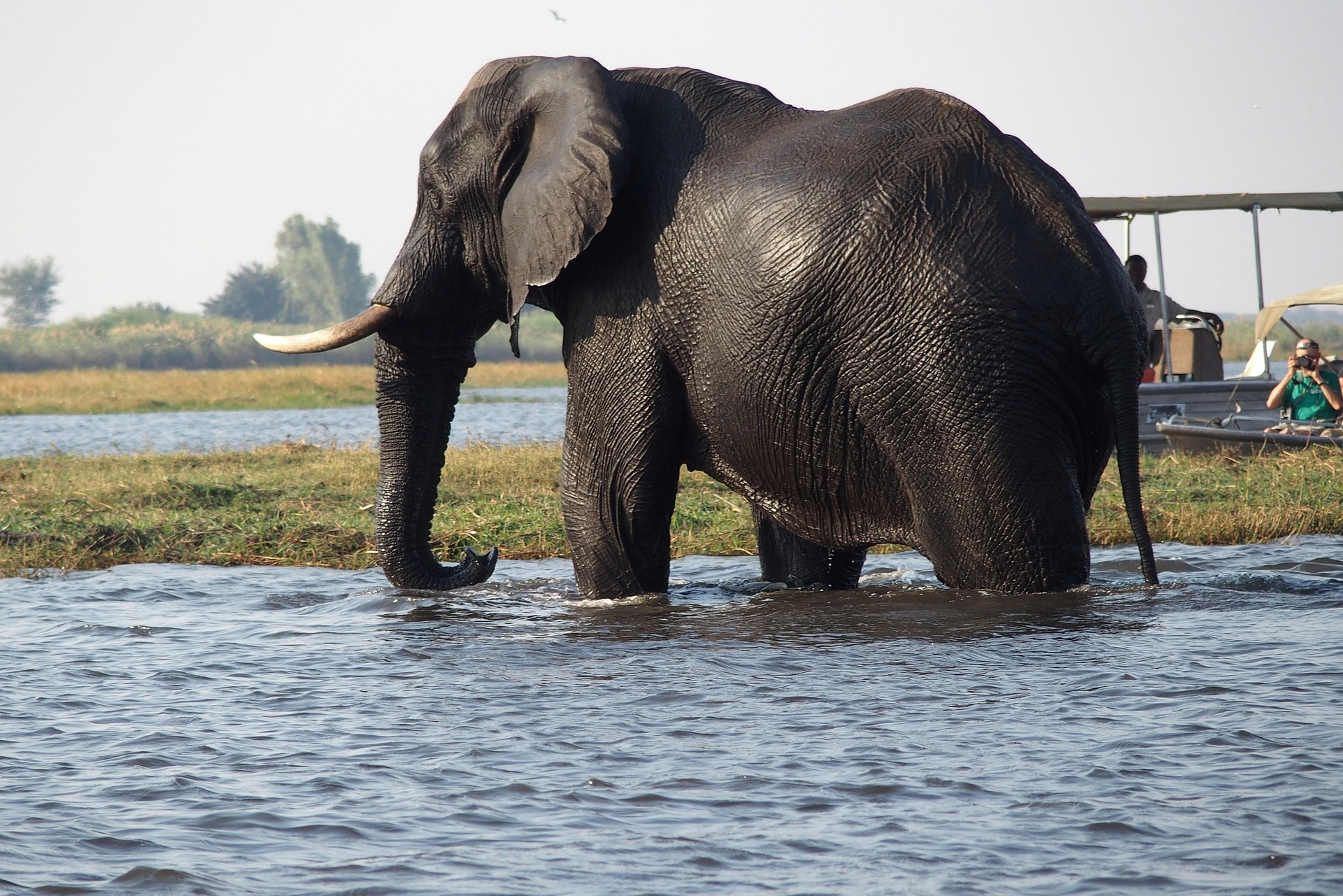


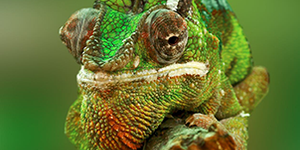
 Zambia
Zambia
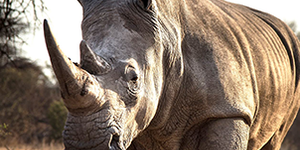
 Australia
Australia
 France
France
 Belgium
Belgium
